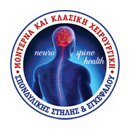
Lower back pain and weight
Demeter Balaska
Dietitian-Nutritionist
Lower back pain or lumbago is the pain in the lower part of the back. It is a symptom (not a disease) and it concerns any pain in the lumbar spine regardless of the causing factor. It can appear suddenly after an abrupt movement or gradually and it gets worse as time passes by. Intense pain is felt around the lower back and it may also be felt in the thigh and it may be accompanied by numbness in the toes. It is one of the most common symptoms someone can have since 80% of the population have experienced it at least once in their lifetime.
Lower back pain is the second leading reason for missed workdays among employees while the first leading reason is the flu. It can affect anyone at any age, but it is more common in people between 30 and 60 years old. It has been observed that in younger people, the pain is usually temporary, while in older patients it is usually chronic. Several factors seem to affect it, such as age, gender, heredity, and the general health condition. Obesity is also considered a factor that turns simple lower back pain into a chronic problem. A recent study (Smuck, 2013) in about 7,000 Americans showed that lower back pain appearance depends on the Body Mass Index (BMI), which shows the severity of obesity. The likelihood of getting lower back pain in people with a normal BMI (ΒΜΙ = 20–25) is only 2.9% but it rises to 11.6% in obese people with a BΜΙ > 36. Exercise seems to decrease this risk, especially in people with a BMI from 26 to 36 (overweight and obese people).
How can lower back pain be treated if the patient is obese?
The first step is weight loss and daily exercise. The main muscle groups that need to be exercised are the abdominal, latissimus dorsi, posterior chain, and gluteal muscles. Sports that exercise the entire body, such as swimming, should be preferred. However, each person is unique and everyone should ideally follow a customized exercise program with the guidance of a trainer.
Regarding weight loss, patients can follow the below mentioned tips:
• Breakfast. It is considered one of the most important meals of the day as it “breaks” the night fasting. Numerous studies have proven that those who don’t have breakfast are 4.5 times more at risk to become obese. Moreover, an intervention study showed that people who started to eat breakfast lost up to 7.7 kilos in contrast with those who kept on not having any breakfast.
• Adequate sleep. There is a correlation between obesity and lack of sleep. A study has shown that those who sleep less than 5 hours a night are 65% more likely to become obese in comparison with those who sleep 7 hours a night.
• Frequent meals. This means three main meals and two small meals in between. Several studies have proven that frequent meals help in hunger and portion control as well as in the prevention of junk food consumption. On top of that, blood glucose
levels are kept balanced.
• Mediterranean diet. This is the first draft of a balanced diet. To follow this diet, fibers such as wholegrain cereal, fruit, and vegetables need to be consumed on a daily basis along with 2–3 servings of dairy and a bit of olive oil. On a weekly basis, 1–2 servings of cooked vegetables, 1–2 servings of fish or seafood, 1–2 servings of legumes, and 1 serving of chicken should be consumed. Finally, red meat should only be consumed twice a month.
• Portion control in each food group. Portion control is necessary for a successful weight loss attempt and also a balanced diet. You can find more information about this in the medNutrition awareness campaign “size…matters!”
• Adequate water consumption. Correct hydration of the body enables nutrients to be absorbed by the cells as well as the toxins to be released.
Finally, it should be noted that quite often, lower back pain needs to be treated surgically. If the patient is obese, they need to follow a weight loss program both preand postoperatively because the extra weight encumbers the spine and this makes recovery more difficult. In these cases, weight loss should be achieved gradually and under the dietitian’s guidance, always in collaboration with the spine doctor (usually a neurosurgeon or rarely an orthopedic surgeon).
You can find information about the surgical treatment of spinal diseases on this website.
Bibliography
Μa Y., Bertone ER, Stanek EJ. Association between eating pattems and obesity in a free-living US adult population. Am J Epidemiol. 2003;158(1):85-92.
Smuck M, Kao MC, Brar N, Martinez-Ith A, Choi J3, Tomkins-Lane CC.Does physical activity influence the relationship between low back pain and obesity? Spine J. 2013;Nov 12. pii: S1529-9430(13)01649-5. doi: 10.1016/j.spinee.2013.11.010
Zoumbaneas Ε. Manolarakis Μ.
How are we supposed to eat, what will you cook… today mom? P. 15-21 Athens: Ellinika grammata.
Papalazarou Α. Knowledge, Thinner in 5 steps. P. 82-119 Athens: Ellin.
Symeonidis P. Diseases and injuries of the Musculoskeletal System, Orthopedics. P. 174-178 Thessaloniki. University Studio Press.






